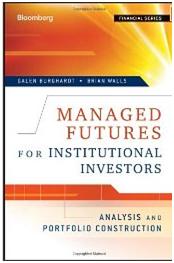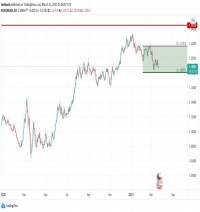|
Well Known Managed Futures Researchers Galen Burghardt and Brian Walls Address Hot Topics of Correlation, Volatility and Study Bias
By Galen Burghardt and Brian Walls Last November we noticed something interesting about the audience at our research forums in New York and San Francisco. We have been organizing these forums for nearly 10 years as a way to discuss investment ideas with fund managers and other investment professionals. All of a sudden a host of pension fund representatives turned up with questions about managed futures. In fact, it appears that for some of these funds, the question is not if they should allocate to managed futures, it's how much. And that prompted us to take a closer look at what might be driving this upsurge of interest. The financial crisis of 2008 and 2009 may well have been the knock on the head that pension funds-and especially defined benefit plans-needed to take managed futures seriously. Their portfolios are tilted heavily toward equities because they need return, but the crisis delivered the second 50% equity drawdown in less than 10 years. Since 1990, equities have produced staggering quantities of risk but have delivered no return to make up for it. For these two decades, even with the bull market of the 1990s, global equities produced a Sharpe ratio of only 0.07. The financial crisis of 2008 and 2009 may well have been the knock on the head that pension funds-and especially defined benefit plans-needed to take managed futures seriously. At the same time, the crisis provided an acid test of the claim that returns generated by commodity trading advisors are uncorrelated with stock and bond returns and therefore reduce the volatility of returns. The crisis also showed that CTAs can make money under the worst of market circumstances and revealed the fact that with CTAs, what you see is what you get. They were accurately valued and they were liquid, often with only a day's notice. We also were invited this year to a two-day investment seminar in Geneva organized by the pension fund for CERN, the pan-European organization that operates one of the world's most advanced facilities for particle physics. CERN has been around since 1954 and its scientists do research into such things as what gives matter its mass and why nature prefers matter to antimatter. We learned that CERN's pension fund is seriously underfunded and the current head of the fund is committed to new approaches to improving its returns and meeting its liabilities. We also learned that CERN has decided to commit 30% of its portfolio to true alternatives, of which managed futures are an important subset, and that CERN is now embarked on a plan to reach this goal over the next few years. So clearly there is a lot of interest in the pension fund world in alternative sources of return and for a number of reasons managed futures seem to fit the bill. The Problem Pension Funds Have to Solve In a nutshell, the problem defined benefit plans face is this. They are seriously underfunded and they need to find returns somewhere. But the raw material they have to work with-global stocks and bonds-does not hold out much hope. As shown in Exhibit 1, global stocks, which promise the highest risk premium, come with volatility and drawdown risks that are very costly for defined benefit plans. And global bonds, which turned in a fairly respectable performance with low volatility, just finished a 30-year run in a world of declining interest rates. Now that interest rates are very nearly zero, there is really no chance that bonds can repeat this performance. Furthermore, pension funds cannot combine stocks and bonds in a portfolio that produces the highest risk adjusted return and then, as the finance textbooks show, leverage the resulting portfolio up to achieve the expected returns they need. So they take the risks they have to by loading up on stocks and underweighting bonds. As a result, we find that equities dominate pension fund portfolios, which can only be explained by their need for return. Against this backdrop, it is no wonder that pension funds are flocking to our conferences in search of a source of returns that can improve things. In a way, the timing could not have been better. The CTA business has come out of the garage and matured in astonishing ways. In 1980, CTAs managed only $300 million in assets. By 1990, that had risen above $10 billion and today they manage nearly $300 billion. And they look like real asset management companies with the disciplined approaches to research, trading, and back office management that are so important to institutional investors. To be clear, it should be noted that the term "managed futures" is broader than "commodity trading advisor," which is a regulatory designation. Many large hedge funds use the same tools as CTAs but prefer being thought of and regulated as a hedge fund. Our research focuses solely on CTAs and so we will stick with this subset of the hedge fund industry for the purposes of this article. Exhibit 1
Managed Futures Returns Are Real, Uncorrelated and Well-Behaved The entire case for why pension funds need CTAs rests on three key characteristics of their returns: first, that they are both real and positive; second, that they are uncorrelated with stock and bond returns; and third, that their volatility is relatively stable. CTA Returns Are Real and Positive While there is a contentious literature on whether CTAs make money or not, we have two indexes of CTA returns that are about as free from selection, survivor, backfill and other insidious biases that are the bane of the hedge fund world in which returns are self reported. To show how CTAs have performed since 1990, we chained together two indices-the Newedge CTA Index and the Barclay CTA Index. Both indices are based on returns net of the usual hedge fund-like fees that CTAs charge. For an investor, the Newedge CTA Index is probably the better index because it uses the returns of roughly 20 of the largest CTAs that are open for investment and willing to provide us with daily returns. It is reconstituted at the beginning of each calendar year, it has never been back-filled and since we began publishing this index in January 2000 there has been only one dropout-Bridgewater, which stopped reporting daily returns in August 2006, at which point their returns were replaced with 0% for the remainder of that year. The main problem with our index is that its history is too short to compare with those of global stocks and bonds. To deal with this, we chose to fill in the 1990s with the Barclay CTA Index. While it covers too many managers to be truly investable, it too has been run live and so is nearly 100% free of backfill bias. To be included, a CTA needs a four-year track record, which is long enough to get past all but the longest backfill periods. In 1990, it included 179 CTAs. By 1999, it included 319 CTAs. And so survivor bias was not a big issue either. Finally, as a reasonable check, we compared the performance of the two indexes for the period from 2000 to April 2011 and they tracked well enough for us to have confidence in the return data we could calculate for the 1990s. When chained together, the result is a net asset value history like that shown in Exhibit 1. As shown in Exhibit 2, the average return over this period was 6.74%, of which 3.22% was over and above a risk-free rate of interest. The resulting Sharpe ratio was 0.35. CTA Returns Are Definitely Uncorrelated As shown in Exhibit 3, CTAs returns over the past 20 years have exhibited very low correlations with global equities (slightly negative at -0.1) and with global bonds (slightly positive at 0.16). Correlations as low as these, assuming that the estimates are reliable, means that CTAs can be an excellent diversifying force in an otherwise conventional portfolio. Comparing monthly returns for global equities and CTAs for these two years, it is clear that the returns are about as uncorrelated as they could be. The estimated correlation between equity and CTA returns for these two years turned out to be -0.38, which would have been a great thing considering what happened to equity returns. If one removes just one data point for October 2008, when stocks lost 22% and CTAs gained just under 5%, the estimated correlation for these two years would have been -0.18, almost exactly the same as it was for the full 20 years. One of the things that concern investors most about correlations is that they let you down when the going gets tough. This is certainly true of many hedge fund returns that reveal their true colors whenever stock prices make big moves. This aspect of CTA returns has impressed Antti Ilmanen, an authority on investment theory who has published extensively in finance and investment journals. In his recent book, Expected Returns, he notes that trend-following strategies, which dominate returns in the managed futures space, display particularly attractive diversification characteristics. Not only are the correlations to other asset classes low but they appear especially negative exactly when most risky assets and institutional portfolios are struggling. He shows in his book that a broad composite of trend-following strategies would have been profitable in 13 of the 15 worst months for global equities between 1985 and 2009 (the 5% tail of 300 months). The empirical track record of trend-followers as safe havens thus challenges that of government bonds-an immensely valuable characteristic for many investors.
This is the first part of a two-part article. The second half of this article will appear in Opalesque Futures Strategies publication, produced at the end of the month. For additional information visit www.NewEdge.com
| ||||||||||||||||||||||||||||||||||||||||||||||||||||||||||||||||||||||||||||||||||||||||||||||||
|
This article was published in Opalesque Futures Intelligence.
|





 RSS
RSS
 Managed Futures researchers Galen Burghardt and Brian Walls wrote the well received book, Managed Futures for Institutional Investors. This is the first part of a two part article penned by the two and it addresses hot topics, such as study bias in managed futures indices.
Managed Futures researchers Galen Burghardt and Brian Walls wrote the well received book, Managed Futures for Institutional Investors. This is the first part of a two part article penned by the two and it addresses hot topics, such as study bias in managed futures indices.












